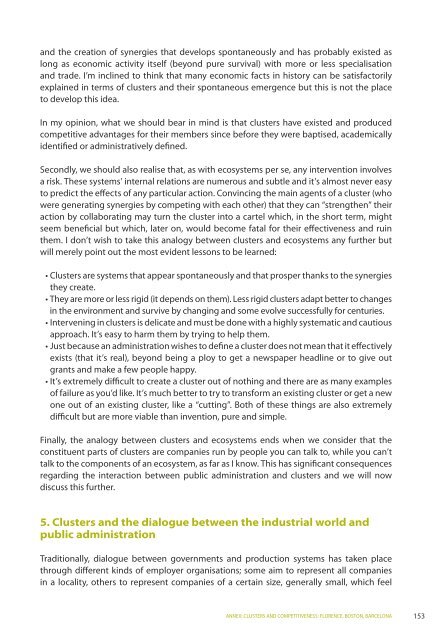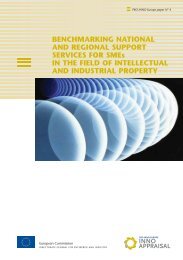Clusters and competitiveness - PRO INNO Europe
Clusters and competitiveness - PRO INNO Europe
Clusters and competitiveness - PRO INNO Europe
Create successful ePaper yourself
Turn your PDF publications into a flip-book with our unique Google optimized e-Paper software.
<strong>and</strong> the creation of synergies that develops spontaneously <strong>and</strong> has probably existed as<br />
long as economic activity itself (beyond pure survival) with more or less specialisation<br />
<strong>and</strong> trade.I’minclinedtothinkthatmanyeconomicfactsinhistorycanbesatisfactorily<br />
explained in terms of clusters <strong>and</strong> their spontaneous emergence but this is not the place<br />
to develop this idea.<br />
In myopinion,whatweshouldbearinmindisthatclustershaveexisted<strong>and</strong>produced<br />
competitive advantages for their members since before they were baptised, academically<br />
identified or administratively defined.<br />
Secondly,weshouldalsorealisethat,aswithecosystemsperse,anyinterventioninvolves<br />
arisk.Thesesystems’internal relations are numerous <strong>and</strong> subtle <strong>and</strong> it’s almost never easy<br />
topredicttheeffectsofanyparticularaction.Convincingthemainagentsofacluster(who<br />
were generating synergies by competing with each other) that they can “strengthen” their<br />
action bycollaboratingmayturntheclusterintoacartelwhich,intheshortterm,might<br />
seem beneficial but which, later on, would become fatal for their effectiveness <strong>and</strong> ruin<br />
them. I don’t wish to take this analogy between clusters <strong>and</strong> ecosystems any further but<br />
will merely point out the most evident lessons to be learned:<br />
• <strong>Clusters</strong>aresystemsthatappearspontaneously<strong>and</strong>thatprosperthankstothesynergies<br />
they create.<br />
• They are more or less rigid (it depends on them). Less rigid clusters adapt better to changes<br />
in the environment <strong>and</strong> survive by changing <strong>and</strong> some evolve successfully for centuries.<br />
• Interveninginclustersisdelicate<strong>and</strong>mustbedonewithahighlysystematic<strong>and</strong>cautious<br />
approach. It’s easy to harm them by trying to help them.<br />
• Justbecauseanadministrationwishestodefineaclusterdoesnotmeanthatiteffectively<br />
exists(thatit’sreal),beyondbeingaploytogetanewspaperheadlineortogiveout<br />
grants <strong>and</strong> make a few people happy.<br />
• It’s extremely difficult to create a cluster out of nothing <strong>and</strong> there are as many examples<br />
offailureasyou’dlike.It’smuchbettertotrytotransformanexistingclusterorgetanew<br />
oneoutofanexistingcluster,likea“cutting”.Bothofthesethingsarealsoextremely<br />
difficult but are more viable than invention, pure <strong>and</strong> simple.<br />
Finally, the analogy between clusters <strong>and</strong> ecosystems ends when we consider that the<br />
constituentpartsofclustersarecompaniesrunbypeopleyoucantalkto,whileyoucan’t<br />
talktothecomponentsofanecosystem,asfarasIknow.Thishassignificantconsequences<br />
regardingtheinteractionbetweenpublicadministration<strong>and</strong>clusters<strong>and</strong>wewillnow<br />
discuss this further.<br />
5. <strong>Clusters</strong> <strong>and</strong> the dialogue between the industrial world <strong>and</strong><br />
public administration<br />
Traditionally, dialogue between governments <strong>and</strong> production systems has taken place<br />
through different kinds of employer organisations; some aim to represent all companies<br />
in alocality,otherstorepresentcompaniesofacertainsize,generallysmall,whichfeel<br />
ANNEX: CLUSTERS AND COMPETITIVENESS: FLORENCE, BOSTON, BARCELONA<br />
153
















